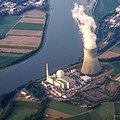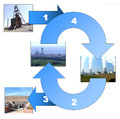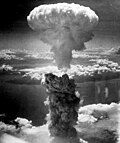Portal:Nuclear technology
The Nuclear Technology Portal
Introduction

- Nuclear technology is technology that involves the nuclear reactions of atomic nuclei. Among the notable nuclear technologies are nuclear reactors, nuclear medicine and nuclear weapons. It is also used, among other things, in smoke detectors and gun sights. (Full article...)
- Nuclear power is the use of nuclear reactions to produce electricity. Nuclear power can be obtained from nuclear fission, nuclear decay and nuclear fusion reactions. Presently, the vast majority of electricity from nuclear power is produced by nuclear fission of uranium and plutonium in nuclear power plants. Nuclear decay processes are used in niche applications such as radioisotope thermoelectric generators in some space probes such as Voyager 2. Reactors producing controlled fusion power have been operated since 1958 but have yet to generate net power and are not expected to be commercially available in the near future. (Full article...)
- A nuclear weapon is an explosive device that derives its destructive force from nuclear reactions, either nuclear fission (fission or atomic bomb) or a combination of fission and nuclear fusion reactions (thermonuclear weapon), producing a nuclear explosion. Both bomb types release large quantities of energy from relatively small amounts of matter. (Full article...)
General images -
Selected article -
Although the case was filed in the Western District of Wisconsin, the judge there recused himself as a friend of the magazine. The case was therefore brought before Judge Robert W. Warren, a judge in the Eastern District of Wisconsin. Because of the sensitive nature of information at stake in the trial, two separate hearings were conducted, one in public, and the other in camera. The defendants, Morland and the editors of The Progressive, would not accept security clearances, as they would have had to sign non-disclosure agreements that would have put restraints on their free speech (including, significantly, in written form), and so were not present at the in camera hearings. Their lawyers did obtain clearances so that they could participate, but were forbidden from conveying anything they heard there to their clients.
The article was eventually published after the government lawyers dropped their case during the appeals process, calling it moot after other information was independently published. Despite its indecisive conclusion, law students still study the case, which "could have been a law school hypothetical designed to test the limits of the presumption of unconstitutionality attached to prior restraints". (Full article...)
Selected picture -
Did you know?
- ... that Project Carryall proposed the detonation of 23 nuclear devices in California to build a road?
- ... that the area of Cultybraggan Camp has been a royal hunting ground, a prison for fervent Nazis and the site of an underground bunker intended for use in a nuclear war?
- ... that an official investigation found the Fukushima nuclear accident was foreseeable and preventable?
- ... that music manager Alan Wills learned about management from his father, who was "in charge of the UK's nuclear early warning system"?
- ... that a nuclear reactor was nearly built at the New York Hall of Science, but the money for the institution instead went to Yankee Stadium?
- ... that the medieval Castle Knob was the site of a Cold War nuclear monitoring station?
Related WikiProjects
Things you can do
| Parts of this portal (those related to section) need to be updated. Please help update this portal to reflect recent events or newly available information. Relevant discussion may be found on the talk page. (September 2021) |
|
Here are some Open Tasks :
|
Selected biography -
Warren was commissioned as a colonel in the United States Army Medical Corps in 1943 and appointed Chief of the Medical Section of the Manhattan Engineering District. He was responsible for the health and safety of the thousands of personnel involved in the Manhattan Project. He was present at the Trinity nuclear test in Alamogordo, New Mexico, where he was responsible for the safety aspects of the detonation of the world's first nuclear weapon. He led a survey team from the Manhattan Project to assess the effects of the atomic bombings of Hiroshima and Nagasaki. In 1946 he was Chief of the Radiological Safety Section of the Joint Task Force for Operation Crossroads, the nuclear test at Bikini Atoll.
In 1947 Warren became the first dean of the School of Medicine at the University of California, Los Angeles (UCLA). Under his leadership, the new school grew from nothing to a major medical school. Although controversial and opposed by James Bryant Conant, Warren would speak out about the dangers of nuclear fallout from weapons testing from about 1947 onwards and upon the Castle Bravo test in 1954 his views were lent some credence, which informed opinion leading up to the Partial Nuclear Test Ban Treaty. Warren became Vice Chancellor, Health Services in 1962 at UCLA. From 1963 to 1965 he served as special assistant to President John F. Kennedy and later Lyndon B. Johnson on mental retardation. Returning to UCLA in 1965, he became professor emeritus, a position he held until his death in 1981. In 1971, he was awarded the Enrico Fermi Award for his contributions to science and medicine. (Full article...)
Nuclear technology news
- 1 August 2025 – Russian invasion of Ukraine
- U.S. president Donald Trump orders the deployment of two United States Navy nuclear submarines near Russia for potential military action against Russian forces in response to statements made by former Russian president Dmitry Medvedev and current deputy chairman of the Security Council of the Russian Federation regarding Trump's previously-stated deadline for ending the war in Ukraine. (Reuters) (BBC News)
Related portals
Related topics
Subcategories
Associated Wikimedia
The following Wikimedia Foundation sister projects provide more on this subject:
-
Commons
Free media repository -
Wikibooks
Free textbooks and manuals -
Wikidata
Free knowledge base -
Wikinews
Free-content news -
Wikiquote
Collection of quotations -
Wikisource
Free-content library -
Wikiversity
Free learning tools -
Wiktionary
Dictionary and thesaurus


























































































